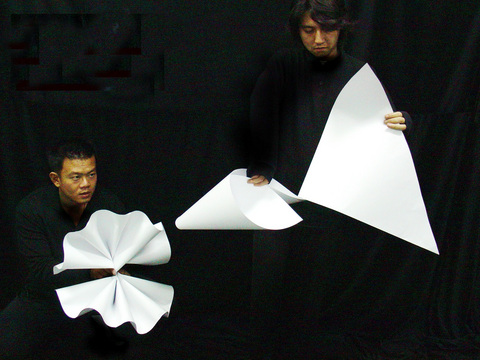Taiwan has a long and distinguished tradition of puppetry based on stories adapted from classical literature or ancient legend.
But over the past six years, however, Sun Chen-chieh (孫成傑) and his Puppet Beings Theater Company (偶偶偶劇團) have been doing a different kind of theater, one that draws on modern puppet theater, which is the inspiration for its latest performance, Paper (紙), beginning tonight at the Taipei Culture Center.
Rather than build puppets made from leather or draw on ancient tales for the story line, Sun strips puppet theater down to its barest elements by taking mundane objects and infusing them with life. He calls it Object Theater.

PHOTO: COURTESY OF PUPPET BEINGS THEATER COMPANY
"You simply take an object and see what it looks like and play with it. We don't try to fix it or figure it out," he said.
The self-taught puppeteer has been doing children's theater for over two-decades.
"When I first started, there [were] no schools and nobody to teach me so I read a lot and watched a lot of puppet theater from Europe and the US," he said. But 10 years ago he felt he had reached the zenith of his knowledge and decided to go abroad to learn different techniques, first from the respected Hungarian puppeteer and pedagogue Jan Dvorak and later at the University of Connecticut under famed puppeteer and director Bart Roccoberton, Jr.
Sun says Object Theater has more freedom to play and experiment with ideas than traditional theater because it's not hindered by a long apprenticeship or ancient stories. This enables Sun to create plays that children can relate to.
But using simple objects and infusing them with personalities is no easy task. Sun and his crew of black-clad puppeteers worked over fifty hours inventing the cast of paper characters for the show.
Before setting out on Paper, Sun searched for the ideal object that could be adapted to the stage. He first thought of the kitchen but soon rejected it because of the many dangerous implements such as knives and forks that could hurt the children he typically performs for. He eventually decided to use paper because of its versatility.
"Paper is a very good thing because you can use it to make sound, you can bend it ... you can do a lot of things because there are different kinds and colors of paper," he said.
The play consists of four 15-minute vignettes. The first is a moral tale about modern society's fear of strangers. "Beginning about twenty years ago, parents tell their children to avoid strangers," Sun said. He tackles this issue head on by having two children run away from an elderly man who has found their ball.
Sun created handheld windmills in a variety of sizes and colors to tell the second story, which concerns issues of identity. The third tale is based on the fable called The Blue Bird. In the final piece, Sun uses rectangular and triangular pieces of paper to create 120 new shapes.
"After viewing the show, we hope that children and parents can go home and create their own shapes," he said.

Wooden houses wedged between concrete, crumbling brick facades with roofs gaping to the sky, and tiled art deco buildings down narrow alleyways: Taichung Central District’s (中區) aging architecture reveals both the allure and reality of the old downtown. From Indigenous settlement to capital under Qing Dynasty rule through to Japanese colonization, Taichung’s Central District holds a long and layered history. The bygone beauty of its streets once earned it the nickname “Little Kyoto.” Since the late eighties, however, the shifting of economic and government centers westward signaled a gradual decline in the area’s evolving fortunes. With the regeneration of the once

Even by the standards of Ukraine’s International Legion, which comprises volunteers from over 55 countries, Han has an unusual backstory. Born in Taichung, he grew up in Costa Rica — then one of Taiwan’s diplomatic allies — where a relative worked for the embassy. After attending an American international high school in San Jose, Costa Rica’s capital, Han — who prefers to use only his given name for OPSEC (operations security) reasons — moved to the US in his teens. He attended Penn State University before returning to Taiwan to work in the semiconductor industry in Kaohsiung, where he

In February of this year the Taipei Times reported on the visit of Lienchiang County Commissioner Wang Chung-ming (王忠銘) of the Chinese Nationalist Party (KMT) and a delegation to a lantern festival in Fuzhou’s Mawei District in Fujian Province. “Today, Mawei and Matsu jointly marked the lantern festival,” Wang was quoted as saying, adding that both sides “being of one people,” is a cause for joy. Wang was passing around a common claim of officials of the People’s Republic of China (PRC) and the PRC’s allies and supporters in Taiwan — KMT and the Taiwan People’s Party — and elsewhere: Taiwan and

On May 2, Chinese Nationalist Party (KMT) Chairman Eric Chu (朱立倫), at a meeting in support of Taipei city councilors at party headquarters, compared President William Lai (賴清德) to Hitler. Chu claimed that unlike any other democracy worldwide in history, no other leader was rooting out opposing parties like Lai and the Democratic Progressive Party (DPP). That his statements are wildly inaccurate was not the point. It was a rallying cry, not a history lesson. This was intentional to provoke the international diplomatic community into a response, which was promptly provided. Both the German and Israeli offices issued statements on Facebook